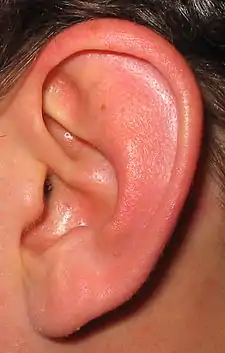ܢܬܐ
Assyrian Neo-Aramaic

ܢܬܐ
Etymology 1
Apheretic form of Aramaic אֶדְנָתָא (ʾeḏnāṯā), plural form of אֶדְנָא (ʾeḏnā), from Proto-Semitic *ʔuḏn-.
Alternative forms
- (Qudshanis, Salamas, Gawar) ܢܵܘܝܼܵܬ݇ܐ (nāwīyā)
Pronunciation
Noun
ܢܵܬܵܐ or ܢܵܬ݂ܵܐ • (nātā or nāṯā) f (plural ܢܵܬܝܵܬܹ̈ܐ (nātyātē) or ܢܵܬ݂ܝ̈ܵܬ݂ܵܐ (nāṯyāṯā) or ܢܸܬ݂ܝ̈ܵܬ݂ܵܐ (niṯyāṯā) or ܢܗܵܬ݂ܝ̈ܵܬ݂ܵܐ (nhāṯyāṯā))
- (anatomy) ear (organ of hearing), auricle
- 2002, “Matthew 11:15”, in Aramaic Bible Translation, transl., The New Testament of Our Lord Jesus Christ and the Psalms in Assyrian:
- ܡ̇ܢ ܕܐܝܼܬ ܠܹܗ ܢܵܬܝܵܬܹ̈ܐ ܠܸܫܡܵܥܵܐ ܫܵܡܹܥ
- man d-īt lēh nātyātē lišmāʿā šāmēʿ
- He who has ears to hear, let him hear!
-
- (animal anatomy) fish gill
- (Hakkari) handle
- Synonym: ܩܲܬܵܐ (qattā)
Usage notes
The plural ܢܵܬ݂ܝ̈ܵܬ݂ܵܐ (nāṯyāṯā) is used by Hakkari and Nineveh Plains dialects. In addition, the alternative plural ܢܸܬ݂ܝ̈ܵܬ݂ܵܐ (niṯyāṯā) is used in the Ashitha dialect and the plural ܢܗܵܬ݂ܝ̈ܵܬ݂ܵܐ (nhāṯyāṯā) in the Alqosh dialect.
Inflection
Inflection of ܢܵܬܵܐ (nātā)
| number | isolated forms | with possessive pronouns | |||||
|---|---|---|---|---|---|---|---|
| state | form | person | singular | plural | |||
| m | f | ||||||
| singular | absolute | – | 1st person | ܢܵܬܝܼ (nātī) |
ܢܵܬܲܢ (nātan) | ||
| construct | ܢܵܬ (nāt) |
2nd person | ܢܵܬܘܼܟ݂ (nātuḵ) |
ܢܵܬܵܟ݂ܝ (nātāḵ) |
ܢܵܬܵܘܟ݂ܘܿܢ (nātāwḵon) | ||
| emphatic | ܢܵܬܵܐ (nātā) |
3rd person | ܢܵܬܹܗ (nātēh) |
ܢܵܬܘܿܗ̇ (nātoh) |
ܢܵܬܗܘܿܢ (nāthon) | ||
| plural | absolute | – | 1st person | ܢܵܬܝܵܬܝܼ̈ (nātyātī) |
ܢܵܬܝܵܬܲܢ̈ (nātyātan) | ||
| construct | ܢܵܬܝܵܬ̈ (nātyāt) |
2nd person | ܢܵܬܝܵܬܘܼܟ݂ (nātyātuḵ) |
ܢܵܬܝܵܬܵܟ݂ܝ̈ (nātyātāḵ) |
{{{pl.2cp}}} () | ||
| emphatic | ܢܵܬܝܵܬܹ̈ܐ (nātyātē) |
3rd person | ܢܵܬܝܵܬܘܼ̈ܗܝ (nātyātuh) |
ܢܵܬܝܵܬ̈ܘܿܗ̇ (nātyātoh) |
{{{pl.3cp}}} () | ||
Etymology 2
| Root |
|---|
| ܢ ܬ ܐ (n t ʾ) |
| 1 term |
Pronunciation
- (Iraqi Koine) IPA(key): /naːte/, [ˈnä.tʰe]
Verb
ܢܵܬܹܐ • (nātē) (present participle ܢܬܵܝܵܐ (ntāyā), past participle ܢܸܬܝܵܐ (nityā))
Conjugation
Conjugation of ܢܵܬܹܐ (nātē)
| singular | plural | ||||||
|---|---|---|---|---|---|---|---|
| 1st person | 2nd person | 3rd person | 1st person | 2nd person | 3rd person | ||
| past | m | ܢܬܹܐ ܠܝܼ (ntē lī) |
ܢܬܹܐ ܠܘܼܟ݂ (ntē luḵ) |
ܢܬܹܐ ܠܹܗ (ntē lēh) |
ܢܬܹܐ ܠܲܢ (ntē lan) |
ܢܬܹܐ ܠܵܘܟ݂ܘܿܢ (ntē lāwḵon) |
ܢܬܹܐ ܠܗܘܿܢ (ntē lhon) |
| f | ܢܬܹܐ ܠܵܟ݂ܝ (ntē lāḵ) |
ܢܬܹܐ ܠܵܗ̇ (ntē lāh) | |||||
| non-past | m | ܢܵܬܹܝܢ (nātēn) |
ܢܵܬܹܝܬ (nātēt) |
ܢܵܬܹܐ (nātē) |
ܢܵܬܲܚ (nātaḥ) |
ܢܵܬܹܝܬܘܿܢ (nātēton) |
ܢܵܬܝܼ (nātī) |
| f | ܢܵܬܝܵܢ (nātyān) |
ܢܵܬܝܵܬܝ (nātyāt) |
ܢܵܬܝܵܐ (nātyā) | ||||
| imperative | m | ܢܬܝܼ (ntī) |
ܢܬܹܝܡܘܼܢ (ntēmun) |
||||
| f | ܢܬܹܐ (ntē) | ||||||
Etymology 3
Intensive form of the above.
Pronunciation
- (Iraqi Koine) IPA(key): /natte/, [ˈnä.tʰe]
Verb
ܢܲܬܹܐ • (nattē) (present participle ܢܲܬܘܼܝܹܐ (natuyē), past participle ܢܘܼܬܝܼܵܐ (nutīyā))
- to protrude
Conjugation
Conjugation of ܢܲܬܹܐ (nattē)
| singular | plural | ||||||
|---|---|---|---|---|---|---|---|
| 1st person | 2nd person | 3rd person | 1st person | 2nd person | 3rd person | ||
| past | m | ܢܘܼܬܹܐ ܠܝܼ (nutē lī) |
ܢܘܼܬܹܐ ܠܘܼܟ݂ (nutē luḵ) |
ܢܘܼܬܹܐ ܠܹܗ (nutē lēh) |
ܢܘܼܬܹܐ ܠܲܢ (nutē lan) |
ܢܘܼܬܹܐ ܠܵܘܟ݂ܘܿܢ (nutē lāwḵon) |
ܢܘܼܬܹܐ ܠܗܘܿܢ (nutē lhon) |
| f | ܢܘܼܬܹܐ ܠܵܟ݂ܝ (nutē lāḵ) |
ܢܘܼܬܹܐ ܠܵܗ̇ (nutē lāh) | |||||
| non-past | m | ܢܲܬܹܝܢ (nattēn) |
ܢܲܬܹܝܬ (nattēt) |
ܢܲܬܹܐ (nattē) |
ܢܲܬܲܚ (nattaḥ) |
ܢܲܬܹܝܬܘܿܢ (nattēton) |
ܢܲܬܝܼ (natī) |
| f | ܢܲܬܝܵܢ (natyān) |
ܢܲܬܝܵܬܝ (natyāt) |
ܢܲܬܝܵܐ (natyā) | ||||
| imperative | m | ܢܲܬܝܼ (natī) |
ܢܲܬܹܝܡܘܼܢ (nattēmun) |
||||
| f | ܢܲܬܹܐ (nattē) | ||||||
References
- “ܢܵܬ݂ܵܐ”, in Sureth Dictionary, Association Assyrophile de France, accessed 2022-12-03
- “ܢܵܬܹܐ”, in Sureth Dictionary, Association Assyrophile de France, accessed 2022-12-03
- “ܢܲܬܹܐ”, in Sureth Dictionary, Association Assyrophile de France, accessed 2022-12-03
- Maclean, Arthur John (1901), “ܢܵܬ݂ܵܐ”, in Dictionary of the Dialects of Vernacular Syriac as Spoken by the Eastern Syrians of Kurdistan, North-West Persia and the Plain of Mosul, Oxford: Clarendon Press, page 219b
This article is issued from Wiktionary. The text is licensed under Creative Commons - Attribution - Sharealike. Additional terms may apply for the media files.